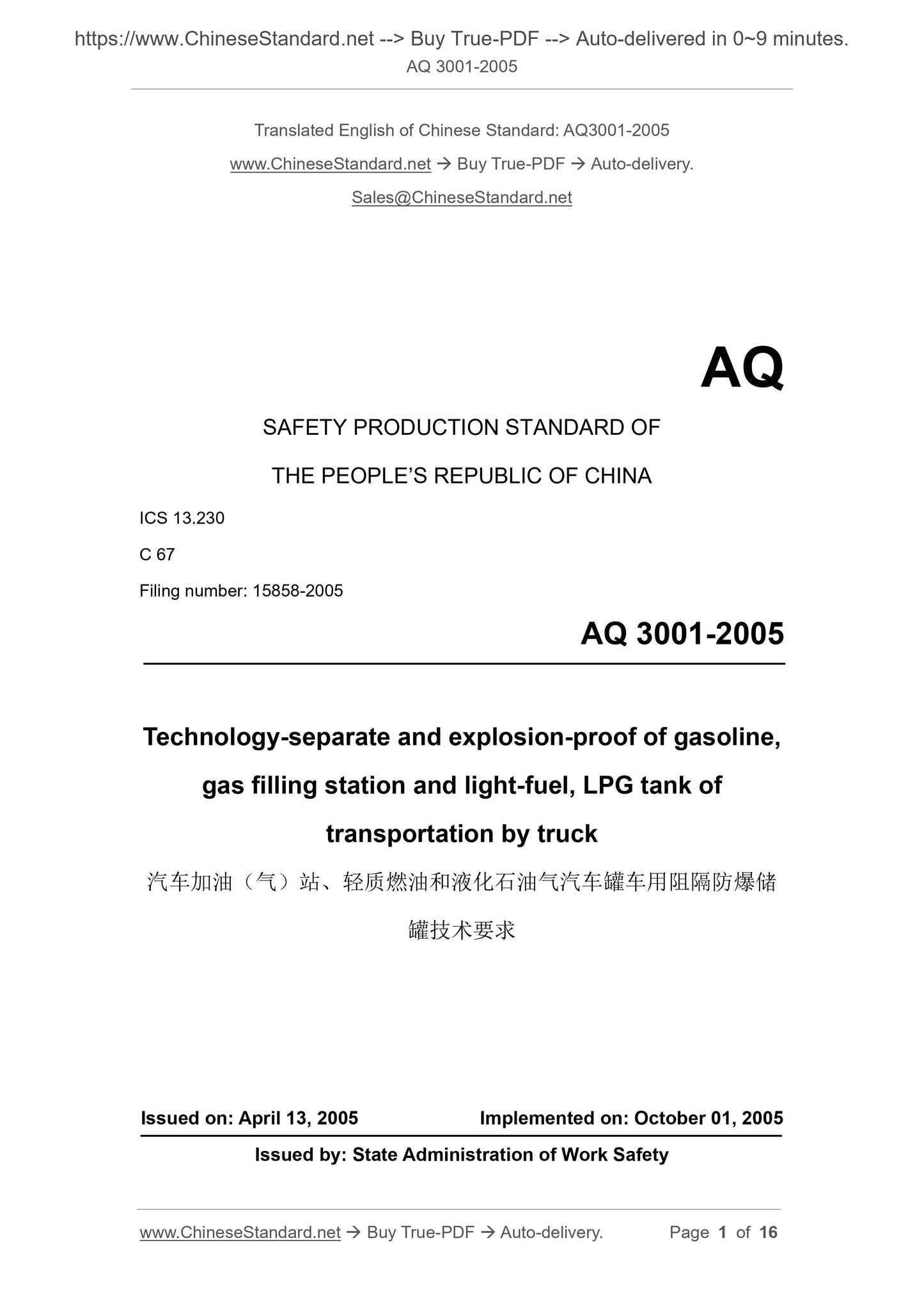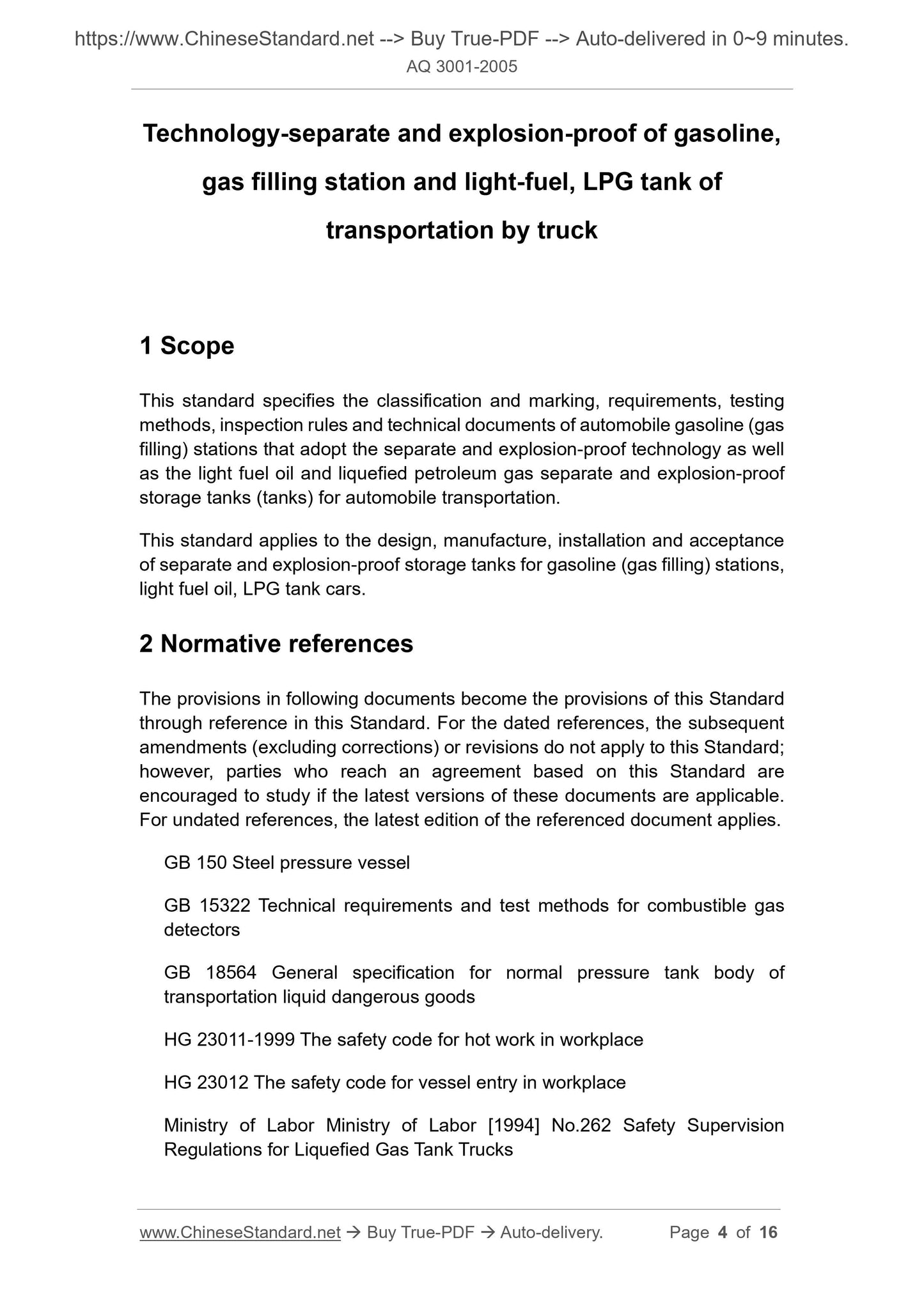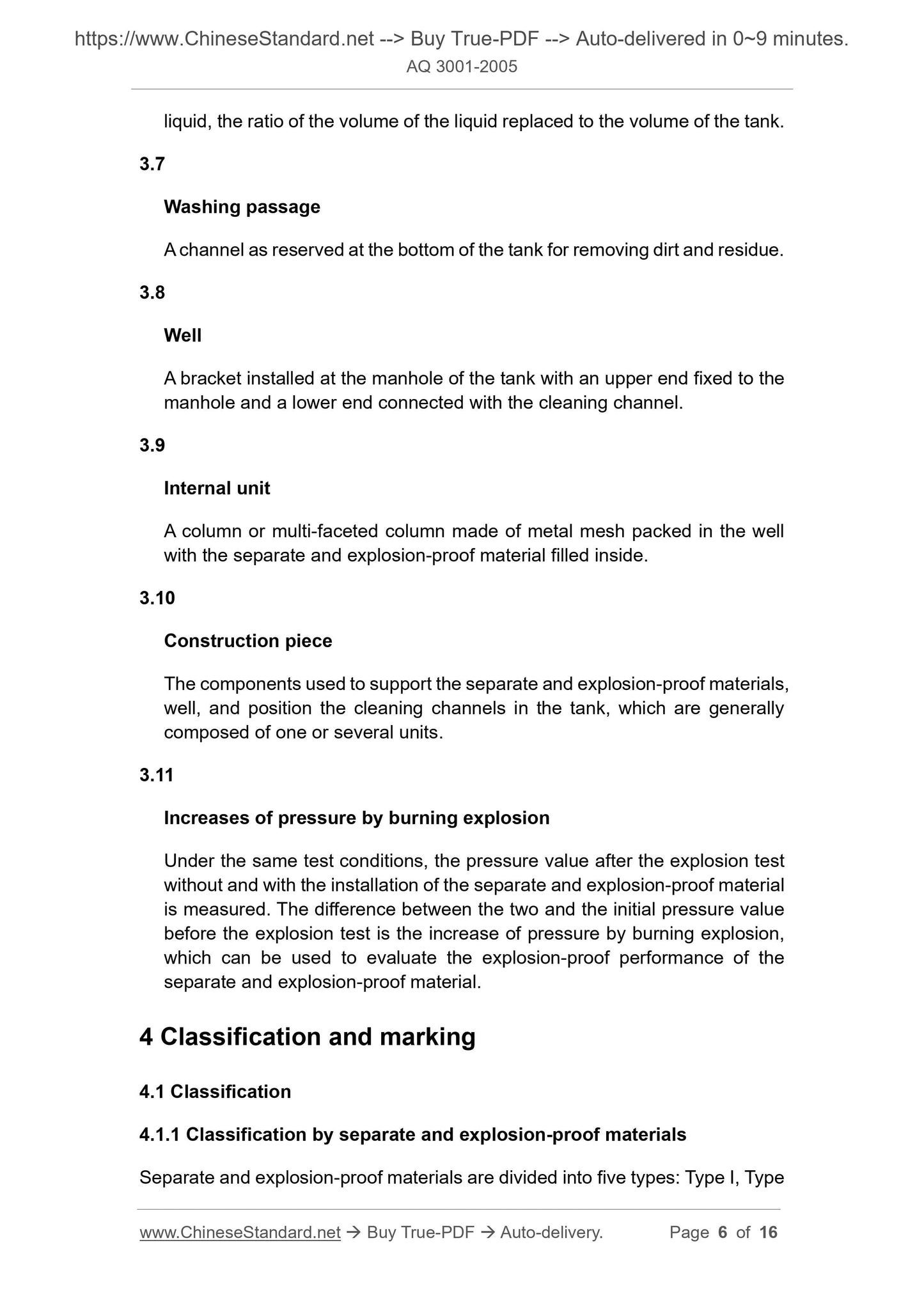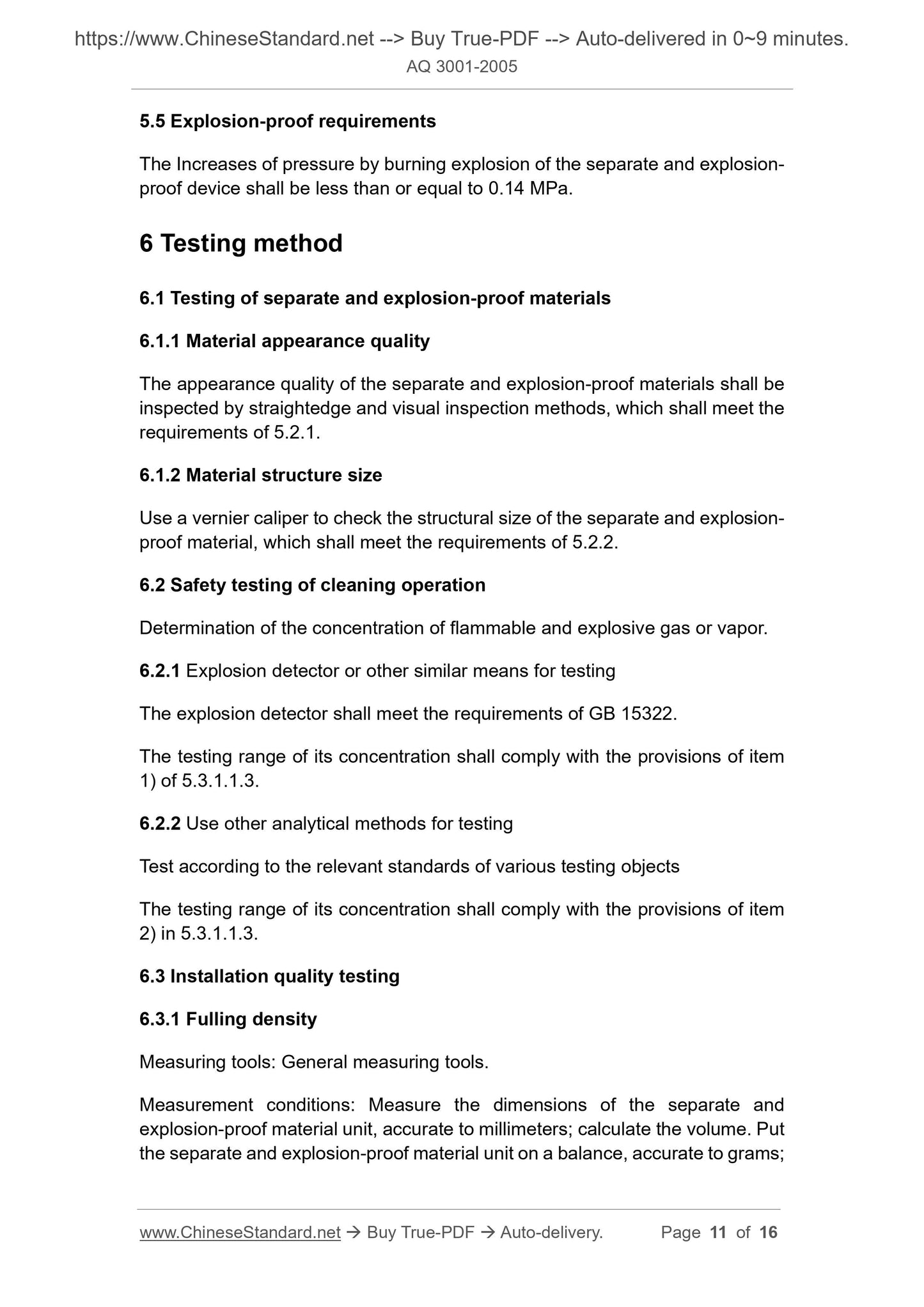1
/
von
9
PayPal, credit cards. Download editable-PDF and invoice in 1 second!
AQ 3001-2005 English PDF (AQ3001-2005)
AQ 3001-2005 English PDF (AQ3001-2005)
Normaler Preis
$190.00 USD
Normaler Preis
Verkaufspreis
$190.00 USD
Grundpreis
/
pro
Verfügbarkeit für Abholungen konnte nicht geladen werden
Delivery: 2 working-hours manually (Sales@ChineseStandard.net)
Need delivered in 3-second? USA-Site: AQ 3001-2005
Get Quotation: Click AQ 3001-2005 (Self-service in 1-minute)
Historical versions (Master-website): AQ 3001-2005
Preview True-PDF (Reload/Scroll-down if blank)
AQ 3001-2005: Technology-separate and explosion-proof of gasoline, gas filling station and light-fuel, LPG tank of transportation by truck
AQ 3001-2005
AQ
SAFETY PRODUCTION STANDARD OF
THE PEOPLE?€?S REPUBLIC OF CHINA
ICS 13.230
C 67
Filing number: 15858-2005
Technology-separate and explosion-proof of gasoline,
gas filling station and light-fuel, LPG tank of
transportation by truck
ISSUED ON: APRIL 13, 2005
IMPLEMENTED ON: OCTOBER 01, 2005
Issued by: State Administration of Work Safety
Table of Contents
Foreword ... 3??
1 Scope ... 4??
2 Normative references ... 4??
3 Terms and definitions ... 5??
4 Classification and marking ... 6??
5 Requirements ... 8??
6 Testing method ... 11??
7 Inspection rules ... 14??
8 Technical documents ... 15??
Appendix A (Normative) Marking of tank using separate and explosion-proof
technology ... 16??
Technology-separate and explosion-proof of gasoline,
gas filling station and light-fuel, LPG tank of
transportation by truck
1 Scope
This standard specifies the classification and marking, requirements, testing
methods, inspection rules and technical documents of automobile gasoline (gas
filling) stations that adopt the separate and explosion-proof technology as well
as the light fuel oil and liquefied petroleum gas separate and explosion-proof
storage tanks (tanks) for automobile transportation.
This standard applies to the design, manufacture, installation and acceptance
of separate and explosion-proof storage tanks for gasoline (gas filling) stations,
light fuel oil, LPG tank cars.
2 Normative references
The provisions in following documents become the provisions of this Standard
through reference in this Standard. For the dated references, the subsequent
amendments (excluding corrections) or revisions do not apply to this Standard;
however, parties who reach an agreement based on this Standard are
encouraged to study if the latest versions of these documents are applicable.
For undated references, the latest edition of the referenced document applies.
GB 150 Steel pressure vessel
GB 15322 Technical requirements and test methods for combustible gas
detectors
GB 18564 General specification for normal pressure tank body of
transportation liquid dangerous goods
HG 23011-1999 The safety code for hot work in workplace
HG 23012 The safety code for vessel entry in workplace
Ministry of Labor Ministry of Labor [1994] No.262 Safety Supervision
Regulations for Liquefied Gas Tank Trucks
liquid, the ratio of the volume of the liquid replaced to the volume of the tank.
3.7
Washing passage
A channel as reserved at the bottom of the tank for removing dirt and residue.
3.8
Well
A bracket installed at the manhole of the tank with an upper end fixed to the
manhole and a lower end connected with the cleaning channel.
3.9
Internal unit
A column or multi-faceted column made of metal mesh packed in the well
with the separate and explosion-proof material filled inside.
3.10
Construction piece
The components used to support the separate and explosion-proof materials,
well, and position the cleaning channels in the tank, which are generally
composed of one or several units.
3.11
Increases of pressure by burning explosion
Under the same test conditions, the pressure value after the explosion test
without and with the installation of the separate and explosion-proof material
is measured. The difference between the two and the initial pressure value
before the explosion test is the increase of pressure by burning explosion,
which can be used to evaluate the explosion-proof performance of the
separate and explosion-proof material.
4 Classification and marking
4.1 Classification
4.1.1 Classification by separate and explosion-proof materials
Separate and explosion-proof materials are divided into five types: Type I, Type
5.3.1 Cleaning before implementing separate and explosion-proof
technology
Implementation of cleaning of separate and explosion-proof technology storage
tank adopts different solutions for new storage tanks and in-use storage tanks.
5.3.1.1 New tank cleaning
5.3.1.1.1 Inspect and determine the reagents for the tank leakage test.
5.3.1.1.2 Choose an appropriate cleaning agent for cleaning operations.
5.3.1.1.3 The safety analysis and qualification criteria are as follows:
a) When using an explosion detector or other similar means, the measured
gas or vapor concentration shall be less than or equal to 20% of the lower
explosion limit;
b) When using other analytical methods, when the lower explosive limit of
the measured gas or vapor is greater than or equal to 4%, the measured
concentration is less than or equal to 0.5%; when the measured lower
explosive limit of the gas or vapor is less than 4%, the measured
concentration is less than or equal to 0.2%;
c) Other requirements shall comply with the provisions of Chapter 6 in HG
23011-1999.
5.3.1.1.4 The operations in the equipment shall comply with the requirements
of HG 23012.
5.3.1.2 In-use tank cleaning
5.3.1.2.1 In order to ensure the construction safety in the transformation
process of the separate and explosion-proof storage tank; the storage tank shall
be cleaned before transformation. Before cleaning, it shall check and determine
the leakage of the storage tank. If it leaks, it shall be repaired and welded to
prevent leakage. Cleaning shall meet the requirements of 5.3.1.1.1 and
5.3.1.1.2 of this standard.
5.3.1.2.2 The safety analysis and qualification criteria shall be in accordance
with the provisions of 5.3.1.1.3 of this standard.
5.3.1.2.3 The operations in the equipment shall comply with the requirements
of HG 23012.
5.3.2 Cleaning of storage tanks after separate and explosion-proof
technology transformation
5.5 Explosion-proof requirements
The Increases of pressure by burning explosion of the separate and explosion-
proof device shall be less than or equal to 0.14 MPa.
6 Testing method
6.1 Testing of separate and explosion-proof materials
6.1.1 Material appearance quality
The appearance quality of the separate and explosion-proof materials shall be
inspected by straightedge and visual inspection methods, which shall meet the
requirements of 5.2.1.
6.1.2 Material structure size
Use a vernier caliper to check the structural size of the separate and explosion-
proof material, which shall meet the requirements of 5.2.2.
6.2 Safety testing of cleaning operation
Determination of the concentration of flammable and explosive gas or vapor.
6.2.1 Explosion detector or other similar means for testing
The explosion detector shall meet the requirements of GB 15322.
The testing range of its concentration shall comply with the provisions of item
1) of 5.3.1.1.3.
6.2.2 Use other analytical methods for testing
Test according to the relevant standards of various testing objects
The testing range of its concentration shall comply with the provisions of item
2) in 5.3.1.1.3.
6.3 Installation quality testing
6.3.1 Fulling density
Measuring tools: General measuring tools.
Measurement conditions: Measure the dimensions of the separate and
explosion-proof material unit, accurate to millimeters; calculate the volume. Put
the separate and explosion-proof material unit on a balance, accurate to grams;
6.4.3 Test conditions
6.4.3.1 The pressure sensor shall meet the following requirements:
a) Range: 0 ~ 10 MPa;
b) Sensitivity: 140 pC/MPa.
6.4.3.2 The pressure gauge shall meet the following requirements:
a) Range: 0 ~ 10 MPa;
b) Accuracy level: 1.6.
6.4.3.3 The test shall be carried out at room temperature of 20 ??C ?? 5 ??C.
6.4.4 Specimen and installation
The test specimen shall be the separate and explosion-proof material which
passes the acceptance in accordance with 5.2.1 and 5.2.2. The size of the
specimen shall be properly matched with the inner wall of the test container;
the cross-sectional area of the specimen shall not be less than 98% of the
cross-sectional area of the inner cavity of the test container. During the test, the
crevice rate inside the test device is 5%. The volume without filling specimen
includes the volume occupied by the observation window. Except for the volume
occupied by the observation window, the remaining volume without filling
specimen shall be located at one end of the ignition source.
6.4.5 Test procedure
a) The air tightness of the test device shall be checked before the test;
perform explosion test of the explosive mixture before the test;
b) Pack the medium in the batching container;
c) Turn on the circulating pump and operate for more than 7 minutes, to
ensure that the mixture in the test container and the combustion explosion
container is uniform;
d) Record the initial pressure (gauge pressure) of the pressure sensor at this
time; close each valve;
e) Test ignition;
f) Record the peak pressure (gauge pressure) of each pressure sensor.
7.2 Installation inspection includes all inspection items.
7.2.1 The test method for the testing of separate and explosion-proof materials
shall be in accordance with the provisions of clause 6.1.
7.2.2 The test method for safety testing of cleaning operation shall be in
accordance with the provisions of clause 6.2.
7.2.3 The test method of installation quality testing shall be in accordance with
the provisions of clause 6.3.
7.2.4 The test method for the testing of explosion-proof performance shall be in
accordance with clause 6.4.
7.3 During the installation inspection, if any item does not meet the relevant
requirements of 6.1 ~ 6.4, the installation is determined to be unqualified. When
the installation fails, it shall be repaired and resubmitted for inspection.
8 Technical documents
8.1 Inspection certificate
Storage tanks using separate and explosion-proof technology shall have an
inspection certificate. The inspection certificate must include the name and
model of the installation organization, inspection date and inspector code, etc.
8.2 Instruction manual
Storage tanks using separate and explosion-proof technology shall have
instruction manual, which includes the shelf life, cleaning methods and daily
maintenance requirements of separate and explosion-proof materials.
Need delivered in 3-second? USA-Site: AQ 3001-2005
Get Quotation: Click AQ 3001-2005 (Self-service in 1-minute)
Historical versions (Master-website): AQ 3001-2005
Preview True-PDF (Reload/Scroll-down if blank)
AQ 3001-2005: Technology-separate and explosion-proof of gasoline, gas filling station and light-fuel, LPG tank of transportation by truck
AQ 3001-2005
AQ
SAFETY PRODUCTION STANDARD OF
THE PEOPLE?€?S REPUBLIC OF CHINA
ICS 13.230
C 67
Filing number: 15858-2005
Technology-separate and explosion-proof of gasoline,
gas filling station and light-fuel, LPG tank of
transportation by truck
ISSUED ON: APRIL 13, 2005
IMPLEMENTED ON: OCTOBER 01, 2005
Issued by: State Administration of Work Safety
Table of Contents
Foreword ... 3??
1 Scope ... 4??
2 Normative references ... 4??
3 Terms and definitions ... 5??
4 Classification and marking ... 6??
5 Requirements ... 8??
6 Testing method ... 11??
7 Inspection rules ... 14??
8 Technical documents ... 15??
Appendix A (Normative) Marking of tank using separate and explosion-proof
technology ... 16??
Technology-separate and explosion-proof of gasoline,
gas filling station and light-fuel, LPG tank of
transportation by truck
1 Scope
This standard specifies the classification and marking, requirements, testing
methods, inspection rules and technical documents of automobile gasoline (gas
filling) stations that adopt the separate and explosion-proof technology as well
as the light fuel oil and liquefied petroleum gas separate and explosion-proof
storage tanks (tanks) for automobile transportation.
This standard applies to the design, manufacture, installation and acceptance
of separate and explosion-proof storage tanks for gasoline (gas filling) stations,
light fuel oil, LPG tank cars.
2 Normative references
The provisions in following documents become the provisions of this Standard
through reference in this Standard. For the dated references, the subsequent
amendments (excluding corrections) or revisions do not apply to this Standard;
however, parties who reach an agreement based on this Standard are
encouraged to study if the latest versions of these documents are applicable.
For undated references, the latest edition of the referenced document applies.
GB 150 Steel pressure vessel
GB 15322 Technical requirements and test methods for combustible gas
detectors
GB 18564 General specification for normal pressure tank body of
transportation liquid dangerous goods
HG 23011-1999 The safety code for hot work in workplace
HG 23012 The safety code for vessel entry in workplace
Ministry of Labor Ministry of Labor [1994] No.262 Safety Supervision
Regulations for Liquefied Gas Tank Trucks
liquid, the ratio of the volume of the liquid replaced to the volume of the tank.
3.7
Washing passage
A channel as reserved at the bottom of the tank for removing dirt and residue.
3.8
Well
A bracket installed at the manhole of the tank with an upper end fixed to the
manhole and a lower end connected with the cleaning channel.
3.9
Internal unit
A column or multi-faceted column made of metal mesh packed in the well
with the separate and explosion-proof material filled inside.
3.10
Construction piece
The components used to support the separate and explosion-proof materials,
well, and position the cleaning channels in the tank, which are generally
composed of one or several units.
3.11
Increases of pressure by burning explosion
Under the same test conditions, the pressure value after the explosion test
without and with the installation of the separate and explosion-proof material
is measured. The difference between the two and the initial pressure value
before the explosion test is the increase of pressure by burning explosion,
which can be used to evaluate the explosion-proof performance of the
separate and explosion-proof material.
4 Classification and marking
4.1 Classification
4.1.1 Classification by separate and explosion-proof materials
Separate and explosion-proof materials are divided into five types: Type I, Type
5.3.1 Cleaning before implementing separate and explosion-proof
technology
Implementation of cleaning of separate and explosion-proof technology storage
tank adopts different solutions for new storage tanks and in-use storage tanks.
5.3.1.1 New tank cleaning
5.3.1.1.1 Inspect and determine the reagents for the tank leakage test.
5.3.1.1.2 Choose an appropriate cleaning agent for cleaning operations.
5.3.1.1.3 The safety analysis and qualification criteria are as follows:
a) When using an explosion detector or other similar means, the measured
gas or vapor concentration shall be less than or equal to 20% of the lower
explosion limit;
b) When using other analytical methods, when the lower explosive limit of
the measured gas or vapor is greater than or equal to 4%, the measured
concentration is less than or equal to 0.5%; when the measured lower
explosive limit of the gas or vapor is less than 4%, the measured
concentration is less than or equal to 0.2%;
c) Other requirements shall comply with the provisions of Chapter 6 in HG
23011-1999.
5.3.1.1.4 The operations in the equipment shall comply with the requirements
of HG 23012.
5.3.1.2 In-use tank cleaning
5.3.1.2.1 In order to ensure the construction safety in the transformation
process of the separate and explosion-proof storage tank; the storage tank shall
be cleaned before transformation. Before cleaning, it shall check and determine
the leakage of the storage tank. If it leaks, it shall be repaired and welded to
prevent leakage. Cleaning shall meet the requirements of 5.3.1.1.1 and
5.3.1.1.2 of this standard.
5.3.1.2.2 The safety analysis and qualification criteria shall be in accordance
with the provisions of 5.3.1.1.3 of this standard.
5.3.1.2.3 The operations in the equipment shall comply with the requirements
of HG 23012.
5.3.2 Cleaning of storage tanks after separate and explosion-proof
technology transformation
5.5 Explosion-proof requirements
The Increases of pressure by burning explosion of the separate and explosion-
proof device shall be less than or equal to 0.14 MPa.
6 Testing method
6.1 Testing of separate and explosion-proof materials
6.1.1 Material appearance quality
The appearance quality of the separate and explosion-proof materials shall be
inspected by straightedge and visual inspection methods, which shall meet the
requirements of 5.2.1.
6.1.2 Material structure size
Use a vernier caliper to check the structural size of the separate and explosion-
proof material, which shall meet the requirements of 5.2.2.
6.2 Safety testing of cleaning operation
Determination of the concentration of flammable and explosive gas or vapor.
6.2.1 Explosion detector or other similar means for testing
The explosion detector shall meet the requirements of GB 15322.
The testing range of its concentration shall comply with the provisions of item
1) of 5.3.1.1.3.
6.2.2 Use other analytical methods for testing
Test according to the relevant standards of various testing objects
The testing range of its concentration shall comply with the provisions of item
2) in 5.3.1.1.3.
6.3 Installation quality testing
6.3.1 Fulling density
Measuring tools: General measuring tools.
Measurement conditions: Measure the dimensions of the separate and
explosion-proof material unit, accurate to millimeters; calculate the volume. Put
the separate and explosion-proof material unit on a balance, accurate to grams;
6.4.3 Test conditions
6.4.3.1 The pressure sensor shall meet the following requirements:
a) Range: 0 ~ 10 MPa;
b) Sensitivity: 140 pC/MPa.
6.4.3.2 The pressure gauge shall meet the following requirements:
a) Range: 0 ~ 10 MPa;
b) Accuracy level: 1.6.
6.4.3.3 The test shall be carried out at room temperature of 20 ??C ?? 5 ??C.
6.4.4 Specimen and installation
The test specimen shall be the separate and explosion-proof material which
passes the acceptance in accordance with 5.2.1 and 5.2.2. The size of the
specimen shall be properly matched with the inner wall of the test container;
the cross-sectional area of the specimen shall not be less than 98% of the
cross-sectional area of the inner cavity of the test container. During the test, the
crevice rate inside the test device is 5%. The volume without filling specimen
includes the volume occupied by the observation window. Except for the volume
occupied by the observation window, the remaining volume without filling
specimen shall be located at one end of the ignition source.
6.4.5 Test procedure
a) The air tightness of the test device shall be checked before the test;
perform explosion test of the explosive mixture before the test;
b) Pack the medium in the batching container;
c) Turn on the circulating pump and operate for more than 7 minutes, to
ensure that the mixture in the test container and the combustion explosion
container is uniform;
d) Record the initial pressure (gauge pressure) of the pressure sensor at this
time; close each valve;
e) Test ignition;
f) Record the peak pressure (gauge pressure) of each pressure sensor.
7.2 Installation inspection includes all inspection items.
7.2.1 The test method for the testing of separate and explosion-proof materials
shall be in accordance with the provisions of clause 6.1.
7.2.2 The test method for safety testing of cleaning operation shall be in
accordance with the provisions of clause 6.2.
7.2.3 The test method of installation quality testing shall be in accordance with
the provisions of clause 6.3.
7.2.4 The test method for the testing of explosion-proof performance shall be in
accordance with clause 6.4.
7.3 During the installation inspection, if any item does not meet the relevant
requirements of 6.1 ~ 6.4, the installation is determined to be unqualified. When
the installation fails, it shall be repaired and resubmitted for inspection.
8 Technical documents
8.1 Inspection certificate
Storage tanks using separate and explosion-proof technology shall have an
inspection certificate. The inspection certificate must include the name and
model of the installation organization, inspection date and inspector code, etc.
8.2 Instruction manual
Storage tanks using separate and explosion-proof technology shall have
instruction manual, which includes the shelf life, cleaning methods and daily
maintenance requirements of separate and explosion-proof materials.
Share

















